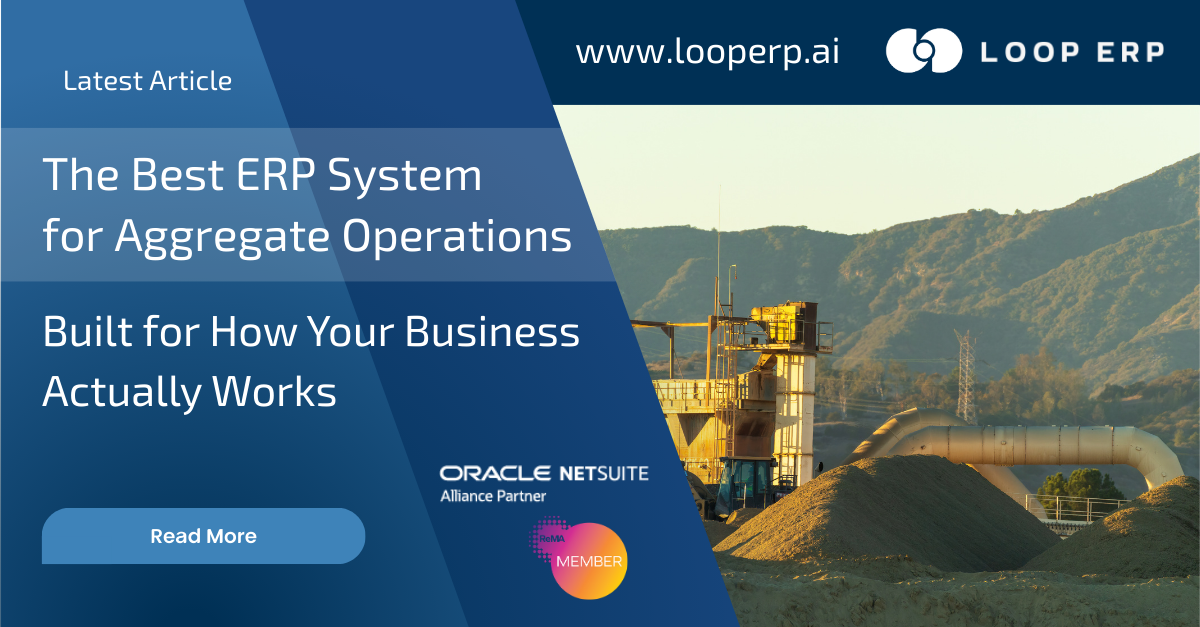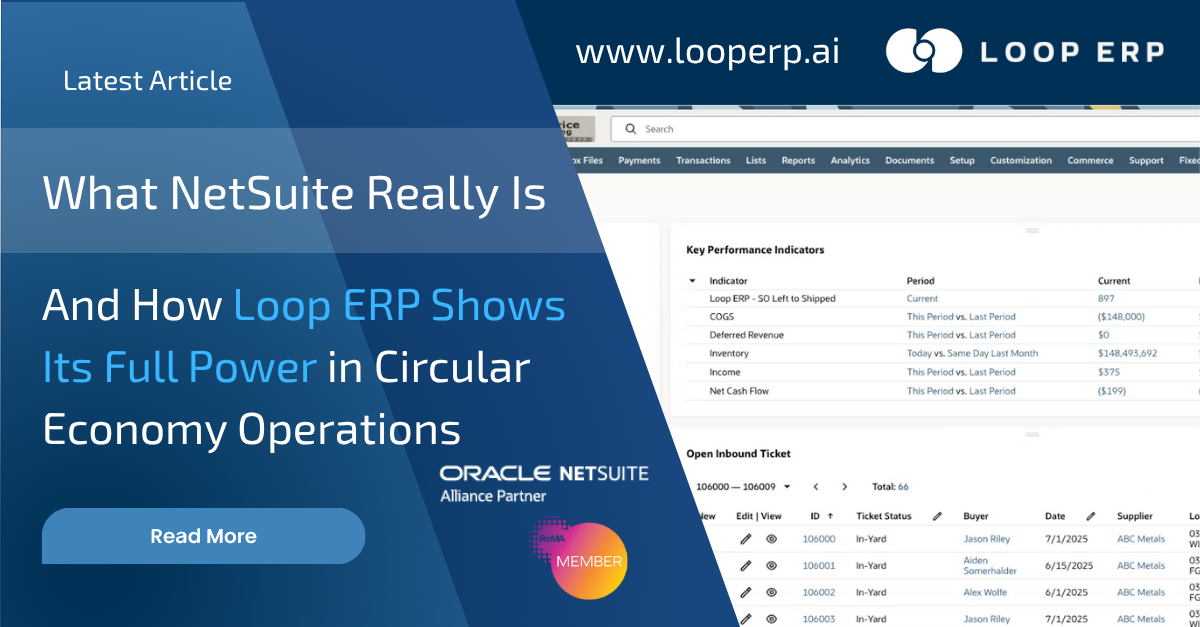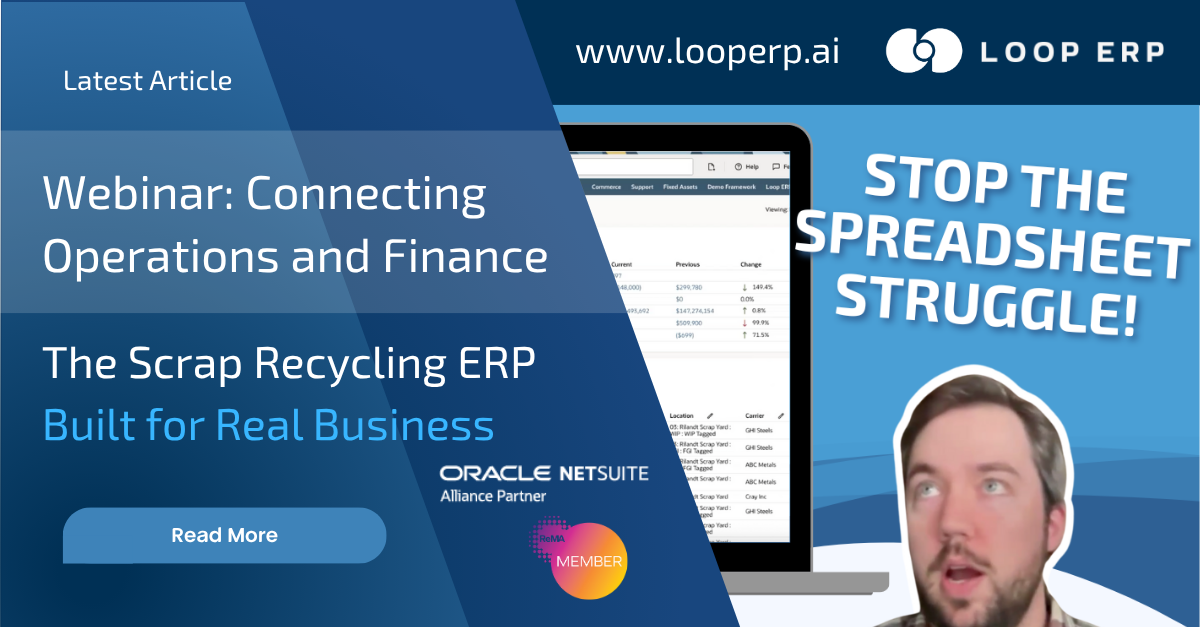
Environmental regulations have traditionally been viewed as a necessary burden. For the circular economy and waste management industry, these regulations consist of complex requirements that demand significant resources while seemingly offering little business value beyond avoiding penalties. This compliance burden has continued to grow in complexity with each passing year, with more reporting requirements, stricter thresholds, and higher documentation standards.
But what if environmental compliance could transform from a cost center into a strategic advantage? What if the same data collected for regulatory purposes could drive operational improvements, open new revenue streams, and create compelling marketing differentiation?
Companies that process scrap, waste and aggregates face uniquely complex environmental compliance requirements that span multiple regulatory frameworks. This means most material transformation businesses operate under overlapping regulatory jurisdictions with different, and sometimes conflicting requirements:
Material transformation businesses typically face numerous federal reporting obligations spanning multiple agencies and regulatory frameworks. These include EPA waste handling reports, Department of Transportation hazardous materials documentation, OSHA workplace exposure monitoring, and often specialized requirements for specific material categories like electronics or automotive components. Each federal program typically has its own reporting formats, submission timelines, and documentation standards, creating a complex compliance matrix even before considering state and local requirements. Companies operating across state lines face the additional challenge of navigating federal regional variations, as enforcement priorities and interpretations often differ between EPA regions even under identical regulatory language.
State environmental regulations frequently impose additional requirements beyond federal standards, creating complex compliance overlays for multi-state operators. States like California, Massachusetts and Washington often implement more stringent thresholds, additional banned substances, or more aggressive implementation timelines than federal requirements. These state-specific regulations typically introduce additional reporting formats, different calculation methodologies, and unique submission platforms from federal systems. For companies operating facilities in multiple states, this creates substantial complexity in standardizing compliance approaches while still meeting each jurisdiction's specific requirements. The challenge intensifies when materials cross state lines during processing, potentially triggering multiple state reporting obligations for the same physical materials.
Beyond federal and state requirements, most material processing facilities operate under site-specific local permits with unique monitoring and reporting conditions. These local permits encompass air emissions, stormwater management, noise limitations, traffic restrictions, and operating hours constraints that vary significantly between municipalities. Local permit conditions frequently include community-specific requirements negotiated during approval processes that have no standardized reporting formats or established compliance methodologies. For multi-location operators, these site-specific variations create significant challenges in developing standardized operating procedures and compliance protocols across facilities. Meeting these hyperlocal requirements often requires maintaining separate tracking systems outside of primary business applications, creating additional reconciliation challenges.

Beyond jurisdiction complexity, different material streams trigger specialized documentation requirements:
Increasingly stringent chain-of-custody requirements demand complete material traceability from source through final disposition. This traceability extends beyond simple transaction records to include evidence of proper handling at each transfer point, appropriate processing methodologies, and eventual end-use verification. For hazardous or regulated materials, this documentation must often include timestamps, handler certifications, and evidence of appropriate containment throughout the lifecycle. The rise of extended producer responsibility programs has further intensified these requirements, with manufacturers increasingly liable for their products even after transferring materials to recycling or disposal partners. Meeting these requirements typically demands capturing significantly more transaction detail than business systems require for financial purposes alone.
Regulations increasingly require verification that materials do not contain banned substances or exceed hazardous thresholds, placing documentation burdens on processors. Material handlers must maintain evidence of testing methodologies, sampling protocols, and laboratory certifications for various restricted substances ranging from heavy metals to persistent organic pollutants. These verification requirements extend to both incoming materials and outgoing products, with responsibility for detection transferring between parties at each transaction point. For companies handling thousands of material variations, maintaining appropriate testing protocols and documentation for each category creates enormous data management challenges. This challenge becomes particularly acute when regulations change, immediately requiring new testing and documentation for existing inventory.
Environmental reports frequently require mass balance calculations that reconcile all incoming materials with outgoing products, residuals, and emissions. These calculations must account for every pound of material through processing stages, including identifying transformation losses, fugitive emissions, and residuals directed to different destinations. For operations handling millions of pounds of material monthly across diverse processing lines, maintaining accurate mass balance without specialized systems becomes nearly impossible. When materials undergo multiple transformations with weight and composition changes at each stage, the accounting complexity increases exponentially. Inaccurate mass balance reporting represents one of the most common compliance violations, often stemming from inadequate systems rather than actual environmental issues.
"Environmental compliance is often seen as a regulatory burden, but with the right systems, it can drive operational efficiency, improve traceability, and create new business opportunities."
Faced with these complex requirements, most companies adopt one of three fundamentally flawed approaches:
Many operations rely on disconnected spreadsheets for environmental reporting, creating data integrity and version control nightmares. These spreadsheet systems typically evolve organically as new requirements emerge, resulting in sprawling file structures with complex links between documents that few people fully understand. Data inconsistencies inevitably emerge as information is manually transferred between operational systems and reporting spreadsheets, creating compliance risks when numbers don't reconcile. When key personnel depart, these homegrown systems often become partially orphaned, with new staff struggling to understand calculation methodologies or data sources. The resulting fragmentation creates significant business continuity risks while consuming excessive staff time for maintenance and reconciliation.
Some companies implement specialized environmental software that operates parallel to but disconnected from their operational systems. While these specialized applications offer environmental-specific functionality, they typically require duplicate data entry or periodic manual imports from business systems. This separation creates perpetual synchronization challenges, with environmental and business data frequently falling out of alignment. When discrepancies emerge, determining which system contains accurate information often becomes a major investigation. The disconnected nature of these systems also prevents using environmental data for operational decision-making, as the information isn't available within primary business intelligence dashboards. This isolation reinforces the perception of environmental compliance as a separate activity from core operations rather than an integrated business function.
Many businesses adopt a "minimum viable compliance" approach focused solely on avoiding penalties rather than extracting strategic value from environmental data. This approach typically involves collecting only the specific data points required for mandatory reports, often at the last minute before submission deadlines. While potentially meeting basic regulatory requirements, this approach misses the opportunity to leverage the same information for operational improvement, customer communication, or competitive differentiation. The resulting reactive compliance posture keeps environmental functions perpetually in crisis management mode rather than contributing strategic value to the organization. This approach also creates significant business risk, as evolving requirements frequently demand historical data that wasn't collected during previous operating periods.
Loop ERP takes a fundamentally different approach to environmental compliance, integrating environmental data collection into core business processes rather than treating it as a separate activity. This integration transforms environmental compliance from an isolated regulatory function into a source of strategic business intelligence.
Loop's approach embeds environmental data collection within standard business transactions, eliminating duplicate entry while ensuring complete documentation:
Loop automatically calculates key environmental parameters from standard transaction weights, eliminating separate data collection for compliance reporting. The system maintains material-specific environmental attributes including recyclable content percentages, emissions factors, energy equivalents, and carbon impact metrics. When materials move through standard business transactions, these environmental factors automatically calculate and accumulate without additional user input. For example, when receiving a load of aluminum scrap, the system simultaneously records the transaction for inventory/financial purposes while calculating and storing the associated carbon offset value, energy savings, and landfill diversion impact. This integration ensures environmental data maintains perfect synchronization with financial records, eliminating reconciliation challenges during reporting periods.
Loop implements sophisticated material property tracking that monitors composition through transformation processes, supporting both compliance verification and product marketing. The system maintains detailed compositional data for both incoming and outgoing materials, tracking how transformation processes affect key environmental parameters. This tracking includes regulated constituents, recyclable percentages, renewable content, and customer-specific attributes required for downstream certification. As materials undergo separation, purification, or blending processes, the system automatically recalculates compositional profiles based on defined transformation rules. This capability proves particularly valuable for documenting regulatory compliance while simultaneously generating product specification sheets that highlight desirable environmental attributes for customers.
Loop implements automated threshold monitoring that alerts appropriate personnel before regulatory limits are approached, preventing violations rather than documenting them afterward. The system continuously tracks key compliance parameters against configured regulatory thresholds, providing progressively urgent notifications as operations approach critical limits. These thresholds can include permitted material volumes, emissions limits, storage duration maximums, or accumulation quantities for regulated substances. By providing advanced warning before violations occur, the system transforms compliance from a reactive reporting function to a proactive management system that prevents issues entirely. This prevention-focused approach not only eliminates potential penalties but also removes the operational disruptions that typically accompany compliance violations.
Loop enables comprehensive tracking of required environmental certifications, ensuring all personnel, equipment, and facilities maintain current compliance status. The system maintains detailed records of certification requirements, current status, and renewal timelines for everything from operator training credentials to facility permits and equipment certifications. Automated notification workflows alert responsible parties well before expiration dates, ensuring continuous compliance without gaps. For organizations maintaining hundreds of individual certifications across multiple facilities, this automation eliminates the common compliance failure of missed renewals due to manual tracking oversights. The system also maintains complete historical records of all certifications, providing instant documentation during regulatory inspections or audit requests.
Loop provides sophisticated document control that ensures regulatory records are properly maintained, versioned, and retained according to compliance requirements. The system creates structured repositories for all compliance-related documentation, automatically associating records with relevant transactions, materials, facilities, and regulatory frameworks. These associations enable instant retrieval of complete documentation packages for any compliance inquiry without manual file searching. Configurable retention policies automatically enforce required maintenance periods for different document types, preventing premature destruction while flagging eligible records when retention requirements expire. For operations subject to frequent regulatory inspections, this organized documentation approach transforms potentially disruptive events into routine demonstrations of well-maintained compliance systems.
Where Loop truly differentiates from traditional approaches is in transforming compliance data into strategic business assets that create competitive advantage. Loop converts routine operational data into powerful sustainability metrics that drive both operational improvement and market differentiation:
Loop automatically calculates comprehensive carbon impact metrics for different material streams, providing powerful data for both operational decisions and customer communications. The system maintains lifecycle assessment factors for various material categories and processing methods, enabling accurate carbon footprint calculations across the entire operation. These calculations incorporate both direct operational impacts and avoided emissions from recycling or material recovery activities. For recyclers and waste processors, these metrics often demonstrate significant positive environmental contributions that can offset other organizational impacts. The resulting quantified environmental benefits provide compelling content for sustainability reports, customer documentation, and public relations materials - transforming technical compliance data into powerful marketing narratives about environmental leadership.
Loop generates detailed landfill diversion documentation that satisfies both regulatory requirements and growing customer sustainability demands. The system tracks diverted materials through each processing stage, calculating total landfill avoidance while documenting exactly how materials were reclaimed for productive use. These calculations support formal diversion rate reporting for regulatory purposes while simultaneously creating powerful marketing content about circular economy contributions. For companies serving environmentally conscious customers, these metrics provide quantified evidence of sustainability impact that can differentiate offerings from competitors. The system can generate customer-specific diversion reports that help clients document their own environmental initiatives, creating additional relationship value beyond the physical materials or services provided.
Loop enables sophisticated resource conservation calculations that translate abstract environmental benefits into concrete, relatable metrics with powerful communication value. Rather than presenting technical environmental data, the system automatically converts impacts into equivalencies like trees saved, cars removed from roads, household energy saved, or water conserved. These translations transform complex environmental information into compelling narratives that resonate with non-technical audiences including customers, communities, and employees. For companies seeking to build environmental leadership positioning, these visualizations provide ready-to-use content for sustainability reports, websites, facility tours, and marketing materials. The system can customize these visualizations for different audiences, presenting technical detail for regulatory purposes while offering simplified equivalencies for general communication.
For companies in scrap metal, waste management, and aggregate industries, environmental compliance requirements continue to expand in complexity and scope. However, with the right approach, the same data collected for compliance purposes can become a strategic asset that drives operational improvement, customer loyalty, and competitive differentiation.
Loop ERP's integrated environmental intelligence transforms compliance from isolated regulatory burden to value-creating business function. By embedding environmental data collection within standard transactions, automating compliance workflows, and enabling strategic utilization of environmental metrics, Loop helps material transformation businesses discover the competitive advantage hidden within their compliance obligations.
In an era of increasing environmental focus throughout the supply chain, the question is no longer whether you'll collect this data - regulations ensure you must - but whether you'll leverage it strategically or simply check compliance boxes. Loop ERP enables you to transform these mandatory activities into market-differentiating capabilities that create lasting competitive advantage.
Learn more about Loop ERP's environmental intelligence capabilities by contacting our industry specialists or requesting a personalized demonstration focused on your specific compliance challenges and market opportunities.
Powerful, self-serve product and growth analytics to help you convert, engage.
Blogs

December 4, 2025
The Best ERP System for Aggregate Operations, Built for How Your Business Actually Works

November 18, 2025
What NetSuite Really Is, And How Loop ERP Shows Its Full Power in Circular Economy Operations

November 7, 2025
Webinar: Connecting Operations and Finance with Loop ERP: The Scrap Recycling ERP Built for Real Business